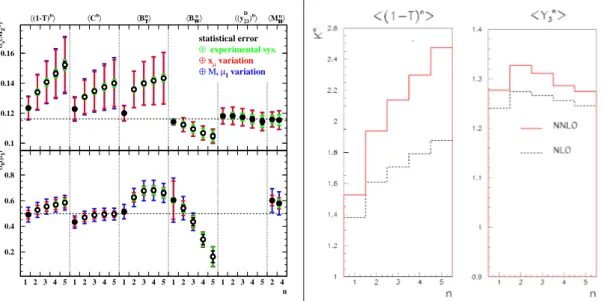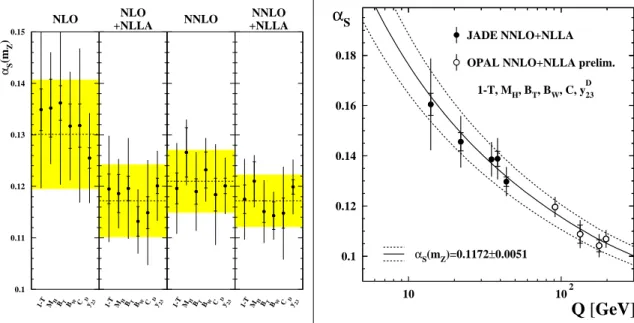PoS(EPS-HEP 2009)292
Determinations of α S and tests of analytic
hadronisation models using e + e − annihilation data
C. Pahl ∗
Max-Planck-Institut für Physik, Föhringer Ring 6, D-80805 Munich, Germany
Excellence Cluster Universe, Technische Universität München, Boltzmannstr. 2, D-85748 Garching, Germany
E-mail: Pahl@mppmu.mpg.de
S. Bethke
Max-Planck-Institut für Physik, Föhringer Ring 6, D-80805 Munich, Germany E-mail: Bethke@mppmu.mpg.de
O. Biebel
LMU München, Fakultät für Physik, Am Coulombwall 1, D-85748 Garching, Germany E-mail: Otmar.Biebel@physik.uni-muenchen.de
S. Kluth
Max-Planck-Institut für Physik, Föhringer Ring 6, D-80805 Munich, Germany E-mail: SKluth@mppmu.mpg.de
J. Schieck
Max-Planck-Institut für Physik, Föhringer Ring 6, D-80805 Munich, Germany E-mail: Schieck@mppmu.mpg.de
and the JADE Collaboration
We report results on measurements of the strong coupling α S from event shape data at PETRA and LEP. Their distributions are analysed employing the new NLLO+NLLA calculations and hadronisation correction by Monte Carlo models using JADE data. This results in a very pre- cise measurement of the strong coupling, α S (m Z
0) = 0.1172 ± 0.0051. The running of the strong coupling is confirmed significantly. Analyses of their moments using next to leading order cal- culations and hadronisation correction by analytical power corrections show shortcomings of the calculations, which can be expected to be alleviated by the NNLO calculations.
The 2009 Europhysics Conference on High Energy Physics, July 16 - 22 2009
Krakow, Poland
∗
Speaker.
cCopyright owned by the author(s) under the terms of the Creative Commons Attribution-NonCommercial-ShareAlike Licence. http://pos.sissa.it/
PoS(EPS-HEP 2009)292
Determinations of α S and tests of analytic hadronisation models using e + e − annihilation data C. Pahl
1. Introduction
The JADE Experiment was operated 1978–1986 at the PETRA collider at DESY, at low c.m.
energies Q = 12–44 GeV where QCD effects are strong. The analysis and detector simulation software has been reactivated and the data have been saved from tapes and printouts to use them for analyses employing new Monte Carlo models and very recent calculations.
Event shapes measure properties of an hadronic event. We employ the variables Thrust 1 − T , C-parameter C and Total Jet Boadening B T , which are sensitive to the whole event; further Wide Jet Broadening B W , Durham two-jet flip parameter y D 23 and Heavy Jet Mass M H , which are sensitive to only one suitable chosen hemisphere of the event. They all vanish for an ideal two jet event, and have an upper limit, e.g. 1 − T = 1/2, for a spherical event. The nth moment of an event shape variable y is defined as hy n i ≡ σ 1 R y n d dy σ dy, so higher order moments probe the multi-jet region.
2. Fits of the moments
Fits of event shape moments aim at specific tests of QCD calculations. The moments hy m i, m=1...5 have been measured by JADE [1] and OPAL [2]. In these tests [3], perturbative predictions are employed in Next to Leading Order (NLO), hy n i = A n ·α S (Q 2 )+ B n ·α S 2 (Q 2 ). The hadronisation correction is performed by analytical “non perturbative” power correction models.
The dispersive model predicts non perturbative corrections supressed with Q and parametrised by a quantity α 0 , which is universal for all event shapes. The predictions for the moments of the distributions fit the data well. Fits of the NLO predictions reveal several non-universalities of the fit parameters. Fig. 1 (left) shows that the α 0 values from one-hemisphere moments hB 1 W i, hM H 2 i and hM H 4 i are rather high. The steeper rise of inverse powers of Q compared to any power of α S
compensates for the uncompletenes of the NLO description of the one-hemisphere variables which is explained in [4].
The α S (m Z
0) values from higher order two-hemisphere moments steeply rise with moment order as already observed in fits of JADE or OPAL data when using hadronisation corrections by Monte Carlo models [1, 2]. The predictions of these moments receive large corrections in α S 2 , see [2] and Fig. 1 (right, dashed lines). The fit results indicate that this trend continues, i.e. for the higher moments of the two-hemisphere variables large contributions in higher orders of α S are missing [6]. This has recently been confirmed in Next to Next to Leading Order (NNLO): The α S 3 contributions [5] increase strongly with moment order for the moments of the two-hemisphere variables, while they are moderate for the one-hemisphere variables. This is shown in Fig. 1 (right, solid lines) for 1 − T and y D 23 .
Moment analyses of the shape function model, which predicts more detailed power correc- tions, give similar results. The single dressed gluon approximation is an approximate calculation available up to α S 6 , and results in a precise measurement, α S (m Z
0) = 0.1172 ± 0.0036.
3. Fits of the distributions
Fits of event shape distributions aim at precise measurement of α S . In these measurements [7], perturbative predictions are employed in NNLO [8]. These calculations are also combined with
2
PoS(EPS-HEP 2009)292
Determinations of α S and tests of analytic hadronisation models using e + e − annihilation data C. Pahl
0.1 0.12 0.14 0.160α(M)sZ
⊕ Μ, µI variation
⊕ xµ variation
⊕ experimental sys.
statistical error
〈(1-T)n〉 〈Cn〉 〈BTTn〉 〈BWWn〉 〈(yD23)n〉 〈MHHn〉
0.2 0.4 0.6 0.8
1 2 3 4 5 1 2 3 4 5 1 2 3 4 5 1 2 3 4 5 1 2 3 4 5 2 4 n α0(µI)
Figure 1: The left figure shows measurements of α S (m Z
0) and α 0 in the dispersive model (no power correc- tions were employed for h(y D 23 ) n i. The right figure [5] shows the the ratios of the first five thrust and Durham flip parameter moments in NLO over leading order (dashed) and in NNLO over leading order (solid) at 91 GeV with α S (m Z
0)=0.124 .
resummed logarithms in the Next to Leading Logarithmic Approximation (NNLO+NLLA). The effects of hadronisation are corrected for by Monte Carlo models.
For comparison studies, the analysis has been performed using NLO, NLO+NLLA and NNLO predictions only. Several effects show that the NNLO predictions are more complete than the respective NLO predictions: The data are described by NNLO+NLLA well over virtually all phase space. The renormalisation scale uncertainty, wich is the largest contribution to the total error, is reduced. This can be seen from Fig. 2 (left), which also shows that the scatter from the different variables is reduced. Using NNLO predictions, combined over events shape variables and JADE energy points, yields α S (m Z
0) = 0.1210 ± 0.0061. Using the NNLO+NLLA predictions results in α S (m Z
0) = 0.1172 ± 0.0051, its 4% precision puts it among the best α S (m Z
0) measurements. Fig. 2 (right) shows that the running of α S (Q) as predicted from the renormalisation group is confirmed strongly in the JADE range 14–44 GeV.
4. Conclusion and outlook
The strong coupling has been measured from six event shape variables using NNLO+NLLA calculations at 14-44 GeV very precisely, α S (m Z
0) = 0.1172 ± 0.0051. The running of α S (Q) has been confirmed strongly in this JADE energy range. Event shape moments reveal shortcomings of the NLO calculations, which are expected to be alleviated by the NNLO calculations.
An OPAL NNLO analysis is in progress, and a NNLO analysis of event shape moments would be interesting. Re-analyses of data taken at the JADE and OPAL experiment have a huge potential, as new calculations and new models are available. As everyone is now looking at the LHC, still precise QCD studies in e + e − physics are also important to the understanding of LHC physics.
3
PoS(EPS-HEP 2009)292
Determinations of α S and tests of analytic hadronisation models using e + e − annihilation data C. Pahl
0.1 0.11 0.12 0.13 0.14 0.15
NLO
α
S(m
Z)
1-T MHBTBWC yD23
NLO +NLLA
1-T MHBTBWC yD23
NNLO
1-T MHBTBWC yD23
NNLO +NLLA
1-T MHBTBWC yD23

